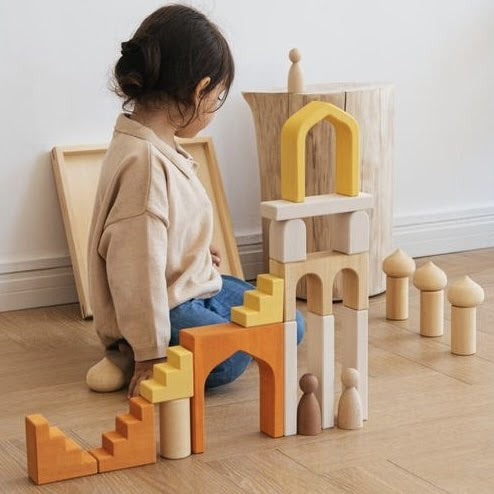Creating a Play Space that Supports Independent Play


As a new school year begins, it’s important to consider the balance between social experiences and independent play. Regardless of how much “fun” children appear to be having (or how extroverted they may be), social experiences can be physically, mentally, and emotionally exhausting. Independent play allows children to unwind, recharge, and process their school experiences.
Independent play can take on many forms. You may find that your child enjoys:
Sensory time (playdough, sensory bins, etc.)
Listening to audio books
Independent block exploration
Solo imaginative play with props, dolls, etc.
Drawing/writing experiences
Independent reading (for pre-readers: browsing books and creating stories inspired by the books’ illustrations)
Wondering where to start? The first step in supporting independent play is reflecting on the play spaces in your home. Head to the room where your family spends the most time playing. Spend a few minutes kneeling, squatting, or sitting at your child’s height.
What can your child see and reach?
Which areas feel most inviting at your child’s height?
Are there any spots that feel cluttered or overwhelming?
Once you’ve experienced this play space from your child’s point of view, you can make a few simple adjustments to support independent play:
★ Add a sturdy step stool to your family’s play space. Low wall hooks are another great tool for children to independently access what they need. The goal is to store play materials at your child’s eyesight and within their reach.
★ Use deep bins and baskets sparingly. While containers are a great way to separate play materials, giant bins filled to the brim can be incredibly frustrating for young children. It’s difficult to see what’s available without dumping the entire bin. Once the contents are dumped, they tend to stick around and clutter the play space.
★ Use smaller, shallow bins and baskets to contain fewer items or store individual play materials on shelves where they can be easily accessed.
★ Remind yourself, “Less is more.” It’s nearly impossible to find a visible spot for every vehicle, toy animal or book. Choose a few that your child adores and store the rest elsewhere. You can try rotating materials from time to time or simply let your child know where you’re keeping the overflow. One day, your child may need that dump truck you’ve tucked away and he or she will know where to find it!
★ Donate books to a family, school or library in need. It’s tempting to fill our homes with every story that moves us! However, books can quickly overwhelm a play space. If you’re not ready to say goodbye to certain books forever, connect with another book-loving family to share and rotate your collections. Just be sure to keep your child’s most beloved books out of the sharing pile and safe at your own home! You can also convert some unused closet space into a mini library and rotate books seasonally.
★ Encourage your child to care for his or her play space by participating in cleanup time. This is especially important as he or she becomes familiar with any changes you’ve made in the play space. When every toy has a designated spot, cleanup is smoother for all!
For more ways to support your child during social transitions, check out our webinar, Positive Language Strategies for Social Settings. Whether your child is heading back to the neighborhood sandbox or beginning school for the first time, you’ll learn effective ways to support your child before, during, and after social experiences.
Recent Articles
-
Playful Primer 10 Must-Have Toys for Your Next Backyard BBQ
Summer is just around the corner and we're ready for it! From backyard BBQs to neighborhood park outings, we've discovered...
read more -
Playful Primer Tips & Toys to Support Group Play Experiences
Catching a glimpse of children happily engaged in pretend play is like witnessing pure magic. Ever wonder how closely you...
read more -
Playful Primer 5 Ways to Strengthen the Bond Between Siblings
“I’ll take care of the bike. You take care of each other.” This is what I said to my children...
read more
